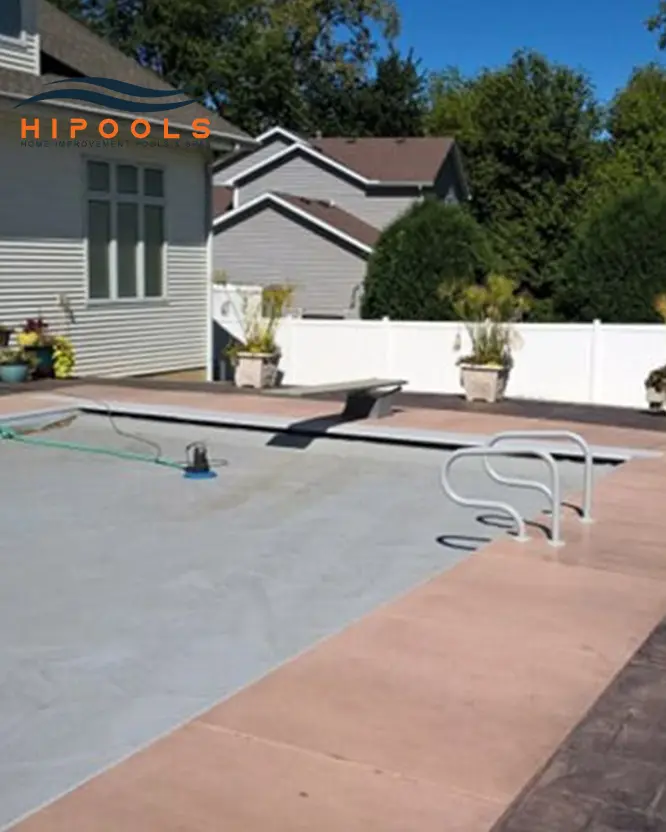Selecting the ideal pool material impacts cost, longevity, and enjoyment. Vinyl liners are budget-friendly comfort but must be replaced every 7–15 years. Fiberglass offers quick installation, minimal maintenance, and longevity (25+ years), though design flexibility is compromised. Concrete provides unmatched customization and longevity but involves greater initial investment and ongoing maintenance. Consider priorities: vinyl allows short-term stinginess, fiberglass balances convenience and longevity, while concrete provides luxury for long-term spending. Compare up-front costs, maintenance needs, and design flexibility to match your lifestyle. Check out our guide to make an informed, splash-tastic decision for your backyard oasis!
Vinyl Pool Liners: Affordable and Customizable Solution for Your Pool
Vinyl pool liners are a popular choice for pool owners looking for a cost-effective and visually appealing option. These liners offer a smooth surface, customizable designs, and a comfortable swimming experience. Let’s explore the cost, maintenance, and replacement aspects of vinyl pool liners, along with their pros and cons.
Vinyl Pool Liner Cost
From a cost aspect, vinyl pool liners are likely the most affordable option. The cost of obtaining a vinyl liner installation is basically lower compared to installing other materials like fiberglass or concrete. On initial installation alone, home owners are capable of saving money without sacrificing quality and appearance.
Vinyl Liner Maintenance
Vinyl pool liners are low maintenance, and therefore a favorite among homeowners wishing to minimize the effort involved with caring for a pool. Vinyl liners are smooth to the touch and resistant to the growth of algae. The liners are also easy to clean and maintain. Brushing and chemical balancing will have your pool in excellent shape. But the older the liner becomes, you will have to put in the occasional repair or patch in order to maintain it.
Pool Liner Replacement
Vinyl pool liners usually last between 7 to 15 years, depending on the extent of exposure to UV light, chemicals, and usage of the pool. While the liner itself is shorter-lived compared to other materials like fiberglass or concrete, replacement is considerably cheaper. The liner can be repaired or replaced in sections individually, so repair is simple and inexpensive. This renders vinyl liners an easy solution for people willing to perform periodic maintenance and replacement.
Pros of Vinyl Pool Liners
- Lower upfront cost: Vinyl pool liners are the most affordable option for initial installation, making them a great choice for budget-conscious homeowners.
- Smooth surface: The smooth surface of vinyl liners is comfortable underfoot and resistant to algae, offering a pleasant swimming experience.
- Customizable designs: Vinyl liners come in a wide variety of patterns and designs, allowing homeowners to choose a style that complements their backyard aesthetic.
- Easy repairs: Unlike other pool surfaces, individual sections of the vinyl liner can be patched or replaced, making maintenance easier and more affordable.

Cons of Vinyl Pool Liners
- Shorter lifespan: The main drawback of vinyl pool liners is their relatively short lifespan of 7 to 15 years. This means that homeowners will need to replace the liner more often than with other materials.
- Vulnerable to tears: Sharp objects or pets can puncture the liner, leading to potential leaks and the need for repairs.
- Limited customization: While vinyl liners offer various patterns and colors, they are often limited by pre-formed shapes, restricting design flexibility for those looking for more unique pool shapes.
Best For
Vinyl pool liners are ideal for budget-conscious homeowners who prioritize cost-cutting measures and convenience over the pool’s durability. Lesser effort in customization of your pool’s appearance and lower installation fee, vinyl liners are a convenient solution for many pool owners.
Fiberglass Pools: A Durable and Low-Maintenance Option
Fiberglass pools offer homeowners a balance of durability, low maintenance, and quick installation. Known for their pre-fabricated shells and smooth finishes, fiberglass pools provide an attractive and long-lasting option for those looking for a hassle-free swimming experience. Here, we explore the benefits, costs, and limitations of fiberglass pool installation.
Fiberglass Pool Installation
The installation of a fiberglass pool is one of its standout features. Fiberglass pools come as pre-made shells that can be installed in just a few days. This quick installation process is ideal for homeowners who want to minimize downtime and start enjoying their pool sooner. The gelcoat finish of fiberglass pools also ensures a smooth surface that is comfortable for swimmers while enhancing the pool’s visual appeal.
Fiberglass Durability
One of the most significant advantages of fiberglass pools is their durability. With proper maintenance, fiberglass pools can last for over 25 years, making them a great long-term investment. The non-porous surface resists algae and stains, reducing the need for constant cleaning and chemical balancing. This makes fiberglass pools a low-maintenance option compared to other materials like vinyl or concrete.
Low-Maintenance Pool
Fiberglass pools are known for their low-maintenance requirements. The smooth, non-porous surface of fiberglass prevents algae from attaching, keeping the pool cleaner for longer periods. As a result, homeowners spend less time scrubbing and cleaning their pool, which can be a significant advantage for those with busy schedules. The gelcoat finish also resists staining from chemicals and organic matter, further reducing maintenance efforts.
Pros of Fiberglass Pools
- Quick installation: With pre-fabricated shells, fiberglass pools can be installed in a matter of days, making them a great option for homeowners looking for a fast solution.
- Low maintenance: The non-porous surface of fiberglass pools resists algae and stains, making them easy to clean and maintain.
- Durable: Fiberglass pools can last over 25 years with minimal repairs, offering long-term value.
- Smooth finish: The smooth, gelcoat finish of fiberglass pools is both comfortable underfoot and visually appealing.
Cons of Fiberglass Pools
- Higher upfront cost: Fiberglass pools tend to be more expensive than vinyl pools, which may be a consideration for budget-conscious homeowners.
- Size/shape limitations: Fiberglass pools are limited to pre-made shapes and sizes, restricting customization options.
- Transport challenges: The large fiberglass shells require adequate yard space and may be challenging to transport, especially in areas with narrow access points.
Best For
Fiberglass pools are perfect for homeowners seeking a balance of durability, low upkeep, and quick installation. If you’re looking for a pool that offers minimal maintenance and a long-lasting structure, fiberglass pools provide a practical and efficient solution. Although the initial investment is higher, the durability and low maintenance costs can make fiberglass pools a great long-term choice.
read for more information about What Type of Pool Needs the Least Maintenance?

Key Comparison Factors
When deciding between vinyl, fiberglass, and concrete pools, it’s essential to weigh several key factors. Each material has its advantages and drawbacks depending on your priorities, such as cost, durability, installation time, and maintenance needs. Here’s a breakdown of the key differences:
1. Cost
- Vinyl: The lowest initial cost, but there will be moderate long-term expenses due to liner replacements.
- Fiberglass: Mid-range upfront costs, but lower maintenance expenses over time.
- Concrete: The highest upfront and ongoing costs, especially for resurfacing and repairs.
2. Time to Install
- Fiberglass (days) > Vinyl (1–2 weeks) > Concrete (2–4 months).
Fiberglass pools install the quickest and concrete pools take the longest installation time due to the lengthy process of construction.
3. Installation Time
- Fiberglass (days) > Vinyl (1–2 weeks) > Concrete (2–4 months).
Fiberglass pools offer the quickest installation time, while concrete pools take the longest to install due to the extensive construction process.
4. Maintenance
- Fiberglass (least) > Vinyl > Concrete (most).
Fiberglass pools are the easiest to take care of, with vinyl being relatively simple, and concrete pools requiring the most rigorous care, such as routine resurfacing.

Which Is Right for You?
Deciding on the best pool material depends on your priorities:
- Budget-first: If you’re looking for the most affordable initial investment, vinyl is your best bet.
- Low-maintenance: For a pool that’s easy to care for with minimal effort, fiberglass is the ideal choice.
- Custom luxury: If you want a high-end pool with extensive design flexibility and long-term durability, concrete is the best option.
| Feature | Vinyl Liner | Fiberglass | Concrete |
| Cost | $20k–$40k | $45k–$85k | $50k–$100k+ |
| Lifespan | 7–15 years | 25+ years | 25+ years |
| Maintenance | Moderate | Low | High |
| Customization | Customization | Limited | Unlimited |
Optimize your pool investment by matching your lifestyle and priorities to the right material!
Vinyl Pool Liner vs. Fiberglass vs. Concrete: Choosing the Best Pool Material for Your Backyard
Selecting the ideal pool material impacts cost, longevity, and enjoyment. Vinyl liners offer budget-friendly comfort but require replacement every 7–15 years. Fiberglass boasts quick installation, low maintenance, and durability (25+ years), though design options are limited. Concrete provides unmatched customization and longevity but demands higher upfront costs and ongoing upkeep. Hi Poolss, serving Georgia homeowners, simplifies your decision with free, no-obligation estimates tailored to your backyard vision.
Ready to dive in?Schedule your free estimate today with Hi Pools’ Georgia-based experts!


No comment